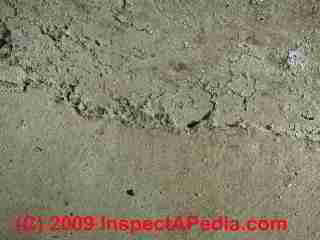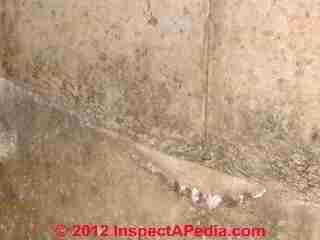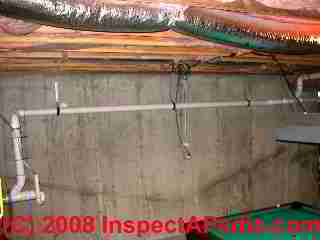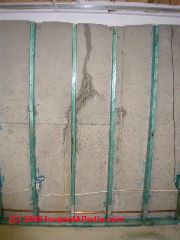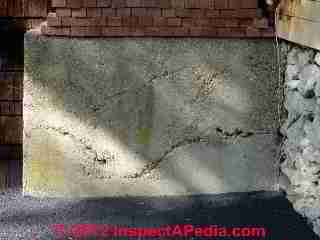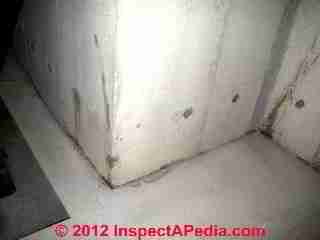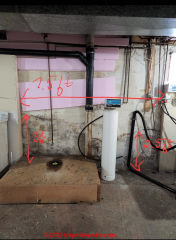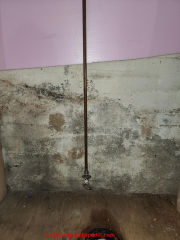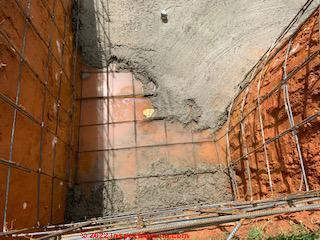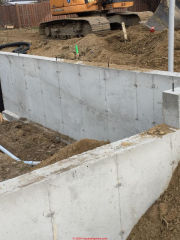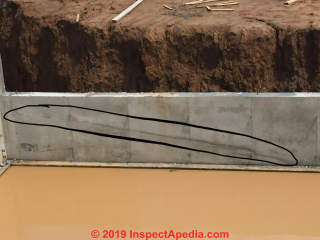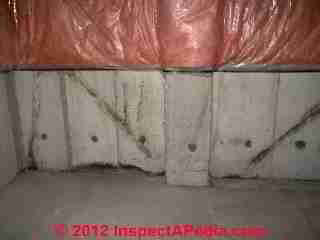 Cold pour joints in concrete foundations & floors
Cold pour joints in concrete foundations & floors
How to identify & if necessary repair cold pour joints & leaks
- POST a QUESTION or COMMENT about concrete cold pour joints, definition, identification, causes, troubleshooting, repair.
Concrete foundation cold pour joints:
This article describes the appearance, cause, & problems that may occur at cold pour joints in concrete foundation walls and occasionally floors or ceilings. A cold pour joint, where successive pours or placements of concrete abut during building construction, are normal but on occasion are leak points that may need sealing or repair.
Cold pour joints in concrete, defined here, are often mistaken for structural damage, cracking, or movement in buildings.
InspectAPedia tolerates no conflicts of interest. We have no relationship with advertisers, products, or services discussed at this website.
- Daniel Friedman, Publisher/Editor/Author - See WHO ARE WE?
How to Identify Cold Pour Joints in Concrete Foundation Walls
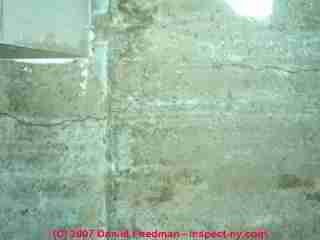 Cold Pour Joints in concrete foundations which leave visible lines in the concrete foundation wall are not usually a structural problem but may in some cases form a dry joint which permits water leakage through the foundation wall.
Cold Pour Joints in concrete foundations which leave visible lines in the concrete foundation wall are not usually a structural problem but may in some cases form a dry joint which permits water leakage through the foundation wall.
Cold pour joints occur because of the time delay between subsequent "pours" into the foundation forms.
An astute inspector, by noting the position, pattern, and slope of the cold pour joint, can probably determine the position from which the concrete was poured into the forms (the high end of the sloping lines) and the extent of delay between pours (evidence of water leaks through the joints indicates that enough time passed for the lower pour to solidify).
Water leaks into buildings at cold pour foundation joints are discussed at Basement Foundation Leak Points - Leaks at Cold Pour Joints.
Our photo (below) provides a closeup of a distinct cold pour joint in a concrete foundation wall of a 1980's home in New York.
Reader Wade Mariage has pointed out that cold pour joints may also occur due to the accumulation of form-release oil on top of a pour into oiled aluminum concrete forms.
As Mr. Wade noted and we agree, even when the concrete crew "chuck" the "mud" (concrete) between pours to improve bonding of the subsequent pour and to reduce pour marks, these marks still often appear in the cured concrete.
If the aluminum concrete forms are heavily oiled the cold pour mark may be still more visible.
Mariage asserts and we agree that normally a cold pour line is not a structural concern. Exceptions are wall leaks or failure of subsequent pours to bond well if the concrete actually sets between pours - unusual events in normal concrete construction.
These close-up photographs of cold pour joints in concrete foundation walls will help in identification of this phenomenon. Notice that there is an apparent boundary that is almost always sloped to some degree and that there are significant texture differences on either side of the diagonal or cold pour joint.
The two concrete cold pour joints shown at left and immediately above are not leaking significantly, though in the lower photo (at left) we see a bit of white stains that are probably mineral effloresence.
Visual clues of cold pour joints give a history of construction sequence and timing
In the photograph above one can just make out the lines of boards used to construct the forms used to pour this foundation wall. The visual clues combine to suggest how this foundation wall was constructed and what happened later.
The use of boards and somewhat rough workmanship suggest a "do it yourself" project, perhaps by a small builder or the homeowners themselves. Small contractors or homeowners might rent a cement mixer and mix small batches of concrete, perhaps not even a cubic yard at a time.
Because a fair amount of manual labor would be involved in mixing each small batch of concrete, it's possible that so much time elapsed between concrete pours that the lower pours had cured and hardened so much that subsequent concrete pours did not bond with their predecessors.
This (speculative) history might explain why we see horizontal cracks in this concrete wall in a pattern which tracks, almost exactly, the cold pour joint lines in the wall. If the builder also skimped on reinforcing steel or wire in the wall that might be another factor in the development of these cracks in response to earth or frost pressure from outside after the wall was cured.
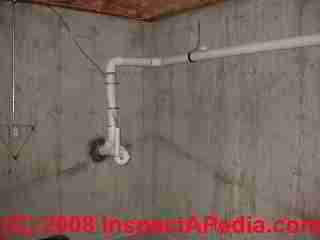
Visual clues of cold pour joints in concrete indicate where the concrete truck or concrete source was located and how full was it during pouring of the foundation
The cold pour joints in this concrete foundation wall show us that the concrete truck made the first pour from the corner of this foundation wall.
Concrete spread roughly evenly away (and sloping down) from each side of the foundation corner as the concrete was poured into the forms. The truck was probably nearly empty when it started this pour as we don't see much height of concrete below the cold pour joint.
A full concrete truck probably made the second pour as we see no other cold pour joints up to the top of the foundation wall.
In the photos above and below you will also notice vertical "marks" in the concrete wall that we discuss below - these are the joints of abutting concrete forms. A nice clue to understanding the vertical joint marks is the concurrent present of concrete form tie marks.
This interesting cold pour joint (at left) tells us that this wall was poured from its two opposite corners, leaving a vee-shaped cold pour joint in the center of the wall.
Although we can see the dark line between the two concrete pours that formed this wall section, as there was no evidence of an actual crack and no water leakage in the wall, this cold pour joint, like the one above, is not a structural concern - it's cosmetic.
Sometimes we can learn something subtle about how a home was constructed and how organized was the builder or mason contractor by observing these clues.
Multiple Diagonal Cold Pour Joints Close Together = many small pours
The following multiple diagonal "cracks" and stains in a poured concrete foundation wall look to us like cold pour joints but in an unusual pattern of closeness and opposing diagonals that might have indicated amateur workmanship or some odd site problem during construction.
And nearly all of the diagonal cracks or joints are leaking along with leaks at some of the form ties and at the floor/wall juncture.
The cold pour joint photos shown above are also discussed in detail in our Q&A section
of DIAGONAL FOUNDATION CRACKS where the reader was concerned that the patterns shown below were evidence of foundation cracking, damage, or movement: they were not.
Vertical "Joints" & Marks in Poured Concrete Walls are not cold pour joints but other cold pour joints may still be present
In my photo at below left we see stains that look like a nearly-vertical cold pour joint in a concrete foundation wall - a pattern caused by a history of water leakage through the wall. This leak, which was not a cold pour joint but looked like one, is discussed
at BASEMENT LEAKS, INSPECT FOR .
In the photo below (when I was a much younger fellow) I was pointing to the origin of a water leak stain high on a foundation wall and a second leak lower into the wall (my left hand) where water was penetrating at form ties.
A nearly-perfectly-vertical line or mark that may appear on some poured concrete walls is more likely to be a mark where the sides of two concrete forms abutted and is not a cold pour joint.
The "vertical mark" in poured concrete walls that is clearly the abutment of concrete forms is shown in the photograph below. But this wall also shows sloping low-diagonal cold pour joints.
[Click to enlarge any image]
Concrete cold pour joints in a hand-mixed hand-poured concrete wall
Our photo above of a portion of the foundation of a home built by hand in the 1940's (built by Mr. Prole, Poughkeepsie, NY) provides unmistakable evidence of a hand-mixed, hand-poured concrete foundation. You will observe considerable variation in the texture of the finished wall as well as multiple cold pour joints.
Photo courtesy Paul & Eric Galow.
How can we distinguish a diagonal structural crack from a cold pour joint in a poured concrete foundation wall?
Reader Question: I am hoping you can help me out here, the home inspector was not very helpful to me for this one. I have attached an image of the foundation cracks in the basement, I am wondering if you can help me identify if there is any structural problems. The outside of the wall is backfill. Thank you so much for your help! - C.C. 9/5/12

Reply: Unfortunately your photos were quite blurry and small, making any detailed examination impossible. I cannot see if you are actually showing photos of actual foundation cracking (such as due to settlement or movement) or if in fact we are looking at foundation wall leak stains along cold pour joints.
In one of your photos the apparent "cracks" look like a Vee shape that would be unusual (not impossible) in foundation settlement but would be common in a cold pour joint. Were there similar marks on other foundation walls? Perhaps cold pour joints that were not leaky so were less obvious? If on the other hand you saw actual separation or broken concrete - then it's a crack not a cold pour joint.
I also see what looks like leak stains along some of these cracks - or joints. Water leakage through a poured concrete foundation wall can indeed occur at all types of cracks and also occurs at some cold pour joints as well as occasionally at form ties.
I am also disappointed in your home inspector - s/he was paid a fee to inspect the home and owes you a useful explanation of what was observed. If the inspector doesn't know - that's fine, and honest - but then unless the inspector is confident that these cracks and stains are meaningless (an opinion I'd doubt as there is evidence of leakage), I'd have expected the inspector to suggest that more expert inspection and diagnosis were appropriate.
Reader Follow up:
Thank you SO much for your detailed response.
They are actual cracks, and I believe there are some white residue left on the walls (possibly efflorescence ?)
Also, the left side of the wall seems like it's a little bent outwards and the right side is bent inwards (think concave and convex).
Is that signs of bulging?
Right now I am asking the inspector to give me full resolution photos of that particular area of the house. (he declined to give me all full size photos for the entire inspection).
Also, because this is sold conditionally to me, I can walk away with no loss. The seller of this house has gotten an injection crack fix quotation ($2500) as well as a structural engineer to report on the structural stability of the house.
I guess at the end of the day, the big question is whether this will be:
1. good structurally? (ie the house won't collapse on me)
2. if the cracks are fixed by injection, will it indeed waterproof the basement?
Thanks again for your help here. I am grateful for the information on your website. - C.C.
Reply:
OK so when we know there are cracks in a foundation wall we need to know:
- cause
- impact on structure
- history & probability of continuing cracking, damage, movement
- proper repair steps
FOUNDATION CRACK DICTIONARY discusses evaluating foundation damage by examining concrete crack size, shape, pattern, and location. If inspection confirms that the foundation wall is actually leaning or bulging, particularly confirming that it was not built in that position, then movement has occurred and an accurate diagnosis is important in deciding what repair work, if any, is needed.
Crack injection into a concrete foundation wall principally addresses water or air leaks, not structural issues in residential applications. (Indeed there are some cases in which epoxies are used also for structural repairs). The risk is that you end up having to do a foundation or footing repair. Far far more than just the cost to seal up cracks.
It's not that a sudden calamitous collapse is imminent - but rather that there is an ongoing settlement problem (bad footings, bad site work, built on fill, something else) that ultimately means foundation repair.
Take a look at the crack evaluation articles at our site if you haven't already done so, keep me posted, send along sharper photos, and let me know other diagnostic data (site properties, cracks present or absent on other walls, etc)
Sharp photos of these foundation cracks and patterns would be helpful and would permit some comment, but they are never a substitute for an onsite inspection by an expert. In my experience, the onsite expert almost always finds important additional information that simply was not apparent to a homeowner nor to others.
Reader Follow-up - Nine Diagnostic Photos of Diagonal Foundation "Cracks" that may be cold pour joints
Here are some more pictures. Hopefully you can offer your experience and shed some light on the situation
Reply:
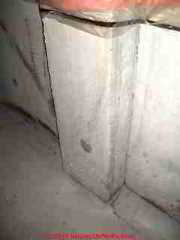
In this photo I notice what a diagonal or sloped concrete "patch" along the joint between the bottom of the foundation wall and the floor - suggesting that someone has been trying to deal with a problem of foundation leakage and basement water entry.
It would be useful to marry this observation with what your home inspector noticed outside the building regarding the condition of the roof drainage system, gutters and downspouts, as well as any surface runoff or grading issues around the home.
Zooming in on the image [Click this or any image to see an enlarged version] these begin to look more like leaky cold pour joints but we can't yet reconcile that opinion with your suspected observation of foundation lean or bulge.
We have some experts among InspectAPedia readers, including some structural engineers familiar with foundation problems - and invite further comments.
In the photos just above and then below (images were lab-enhanced from as-received) water leak stains are plain at form ties (photo below left, left side), at the floor/wall juncture, and at the diagonal cracks.
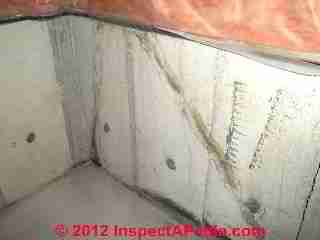
The photos below offer closer views that look to me like cold pour joints that were leaking.
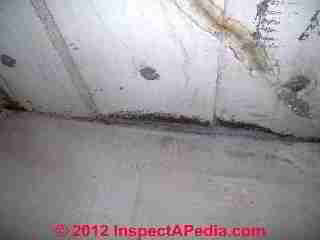
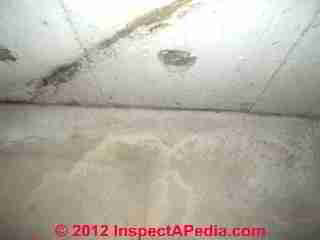
Your last two photos (below) illustrate an unusual number of unusually close together diagonal foundation crack patterns, nearly all of which have also been leaking.


Even where I find cold pour joints in foundation walls, the only time I see so many such marks so close together is in a poured concrete foundation that was mixed by hand or set in place using many small-quantity concrete pours with enough time delay between each successive pour that there was poor bonding between them.
Certainly the diagonals would appear to "contradict" one another in their indications of directions of foundation movement or settlement- a further argument for cold pour joints and either some very unusual site conditions during construction or amateur workmanship.
You didn't say where this home is located nor if it's in an earthquake zone. But while we see other close-set structural cracks in areas of earthquake damage, it would be unusual for a severely earthquake-damaged building to show vertical and diagonal foundation cracks with absolutely no lateral movement or dislocation.
I would like to examine some really sharp close-up photos of some of those crack areas in order to look for classic cold pour joint details in comparison with cracks due to shrinkage, loading, structural movement, but I SPECULATE from the crack pattern, location, even the contradicting directions of cracks in nearby wall sections, that these are leaky cold pour joints.
These walls look as if an amateur concrete mason built the foundation out of a large number of small pours.
See if you can find out the age of the house, who built it, and who did the foundation work, and if neighboring buildings by the same contractor built at the same time have similar foundation leaks and damage. .
We've either got cold pour joints or a unique heave/settlement/absence of reinforcement problem that is unusual.
I'd be more confident about my guess if I could look closely at the concrete around those cracks - you can do that. First take a look at some of my cold pour joint photos so you know what you are looking for. IF the concrete is smooth, uniform, on both sides of the crack, then it's a break or crack; if the concrete is rough, funny looking along the area of cracking, you may be able to spot where two successive pours of concrete met one another after enough time had elapsed between the first and second pour such that there was little mixing, blending, adhesion between the two pours.
- If they are cold pour joints with no other movement nor lateral dislocation, then this is not a structural nor settlement hazard it's a leak problem
- If there is weird foundation settlement or earthquake damage, then the foundation is a mess and needs expert diagnosis and assessment.
- Tell me the age and location of the home and what else you can about its history, including the condition of roof and site drainage, frost exposure?
- Tell me if you can find out by asking neighbors if there are similar problems on other homes by the same builder.
Reader Follow-Up:
The house is only 8 years old. The grading outside is nothing too unusual. The roof has proper drainage as well. I went to a friends house who is in the same row and he doesn't have that problem. do you think a crack fix from outside and a vapor barrier outside of the foundation will prevent leakage for good? When i told people about my worries, That solution was what I have been told by multiple people. -C.C.
Reply:
C.C., before choosing a "repair" we must be confident that we understand the problem - otherwise it's likely to be money wasted.
Fixing leaks from outside the building is usually the best approach but if the problem is not just a roof gutter/downspout or surface runoff problem, that is, if the proposal involves excavating the foundation to install a waterproofing system or new footing drains, that approach will also the most expensive; that's why we prefer to start fixing foundation leakage by finding and fixing sources of outside leaks. Start by looking at the roof drainage system and surface runoff/grading.
At WATER ENTRY in BUILDINGS we provide a series of articles detailing approaches to basement waterproofing, starting with the simple, inexpensive basics but also including the use of excavation, geotextiles, etc.
Research citations on cold pour joints, effects of cold pour joints on concrete durability & cold pour joint sealing procedures for concrete
- Baragary, Chance, and Hani A. Salim. "Effects of cold joints in blast resistant structural concrete [abstract]." In 2007 Undergraduate Research and Creative Achievements Forum (MU). University of Missouri--Columbia. Office of Undergraduate Research, 2007.
- Biel, Timothy D., and Hosin Lee. "Performance study of portland cement concrete pavement joint sealants." Journal of transportation engineering 123, no. 5 (1997): 398-404.
- Bussell, M. N., and R. Cather. Design and construction of joints in concrete structures. Vol. 146. Thomas Telford, 1995.
- Collepardi, M., R. Khurana, and M. Valente. "Construction of a dry dock using tremie superplasticized concrete." ACI Special Publication 119 (1989).
- Den Entwurf, Neue Deutsche Richtlinie Für, Zur Rückhaltung Von Wassergefährdenden Von Betonbauten, Nouvelle Directive Allemande Sur La Conception, R. E. T. E. N. T. I. O. N. De Produits, And Dangereux Pour L'eau. "New German Guideline For Design Of Concrete Structures For The Containment Of Hazardous Materials." Otto-graf-journal 17 (2006): 9.
- Erickson, Scott. "Pervious concrete durability testing." In Proceedings of the 2006 Concrete Technology Forum. 2006.
- Fowler, T. J. "Lessons Learned from Refractory Concrete Failures." ACI Special Publication 57 (1978).
- McCurrich, L. H., and N. R. Cook. "Airfield and road pavement use in the UK of high performance coal tar pitch PVC joint sealants, and a comparison of UK and ASTM standards." ACI Special Publication 70 (1981).
- Odum-Ewuakye, Brigitte, and Nii Attoh-Okine. "Sealing system selection for jointed concrete pavements–a review." Construction and Building Materials 20, no. 8 (2006): 591-602.
- Ribeiro, AC Bettencourt, J. Díez-Cascón, and A. F. Gonçalves. "Roller compacted concrete-tensile strength of horizontal joints." Materials and Structures 34, no. 7 (2001): 413-417.
- Sarsam, K. F., and M. E. Phipps. "The shear design of in situ reinforced concrete beam–column joints subjected to monotonic loading." Magazine of Concrete Research 37, no. 130 (1985): 16-28.
- Soliman, Haithem, Ahmed Shalaby, and Leonnie Kavanagh. "Performance evaluation of joint and crack sealants in cold climates using DSR and BBR tests." Journal of Materials in Civil Engineering 20, no. 7 (2008): 470-477.
- Yan, Shangyao, and Weishen Lai. "An optimal scheduling model for ready mixed concrete supply with overtime considerations." Automation in Construction 16, no. 6 (2007): 734-744.
- Yildirim, Yetkin, Yusuf Yurttas, and Ilker Boz. "Service Life of Crack Sealants." In First International Conference on Pavement Preservation. 2010.
...
Reader Comments, Questions & Answers About The Article Above
Below you will find questions and answers previously posted on this page at its page bottom reader comment box.
Reader Q&A - also see RECOMMENDED ARTICLES & FAQs
On 2022-03-20 by Samantha - Inaccurate diagnosis by appraiser
@Inspectapedia Com Moderator, Thanks so much for the reply and reassurance! I had a foundation expert look at it and he came to the same conclusions as you! Now, I'll need to convince the bank and challenge the appraisal.
On 2022-03-05 by Inspectapedia Com Moderator
@Samantha,
An appraiser's expertise is in estimating the value of property by comparing it to comparable homes and understanding market conditions in the sale of Real Estate.
An appraiser normally has no training in Structural Engineering, Foundation construction or even home inspection.
And although your appraiser may have some other background about which we know nothing, he or she should have been able to recognize that cold poor joint in concrete if he or she a professor's expertise in concrete foundations.
Therefore it's no surprise that your appraiser APPARENTLY doesn't know the difference between a structural crack in a cold pour joint.
From those photos it certainly looks like a cold pour joint in every respect.
If you accompany that point with an inspection by a qualified person who knows structure, concrete foundations, and building inspection, such as a structural engineer or even a licensed home inspector familiar with concrete foundations, or perhaps a concrete masonry contractor, along with evidence that there is no Foundation movement nor other damage associated with the cold pour joints, that should be the end of the question.
Frankly it's unusual to find an appraiser who steps out of their area of expertise.
I suppose the cold pour joints were so obvious that an appraiser who didn't know what they were might be nervous
On 2022-03-05 Samantha
Hello inspectapedia!
Thanks for the very informative article. I believe I have a few visible cold joints in my basement foundation wall. I recently tried to finance the home but the bank rejected my application because the appraiser cited structural damage/horizontal cracks in the foundation.
What are your thoughts based on the images? Do I have grounds to appeal the appraisal? Can I just seal the cracks up?
On 2021-12-13 by Inspectapedia Com Moderator
@MACK,
Just to be sure that you and I don't embarrass ourselves when you talk to your contractor, be sure that you read the description above the normal cold pour joints in poured concrete walls and foundations.
It's pretty unusual for a cold pour do you want to be a serious problem in the building but there are rare cases where you could have leaks if the work was quite rough. It should be easy to simply apply an appropriate sealant on both sides of the wall.
On 2021-12-12 by MACK
@Inspectapedia Com Moderator, I'm not sure but I'm going to find out that's for sure. It looks bad but I don't mean anesthetically... I'm terrified of water infiltration... also my electrical panel will be exactly there on that wall in the basement.... not exactly where I want a leak.
On 2021-12-12 by Inspectapedia Com Moderator
@MACK,
From visual inspection of a photo I can't say, but as this is well above ground a leak into the wall ought to be unlikely unless you can see daylight or squirt water through even now.
From what I can see this is probably a cosmetic issue only. But certainly if you're concerned you can coach of the inside and outside of that cold pour joint with a concrete ceiling product.
There was reinforcing steel mesh or rebar inside this wall, correct?
On 2021-12-11 by MACK
This dry joint has me very stressed... it looks like it will leak for sure and looks loose/crumbly. Thoughts??
The seam, crack, joint is visible inside and out... and does run below into the tared area but seems more solid. Also alot of that area not tarred will be back filled and as such below grade. I'm quite freaked out by this... what should I be asking for as a fix from the contractor... my first instinct is a complete repour but that's a newbies reaction I'm sure. BUT I want it properly addressed before its back filled. I've added an image of the reverse (inside), too.
On 2020-08-20 by (mod) - ask ICF product supplier for recommended repair procedure
Lola
It's normal for mistakes to happen during construction; I take comfort knowing that no problem we encounter is likely to be unique, and that somebody has usually already figured out a proper repair for it. Talk with your ICF foundation product supplier and ask what repair procedure they recommend when we need to cut and modify a foundation after construction.
On 2020-08-17 by Lola
Hi There!
We are building ICF foundation in Infill project. They installed window at wrong location. Is it advisable to cut new window and fill the wrong void space?
Its been a month since original foundation date. Do you think its a red flag for future leaks, where he is planning to do patch work?
On 2020-07-02 by (mod) - Incomplete swimming pool pour
Ben
"Gunnite" is a form of "shotcrete" or dry-mix concrete that is shot out of a hose (water is added at the moment it's shot onto a surface), its use in pool construction is widespread; using it on the pool bottom in lieu of wet mix is probably fine but beyond my expertise.
A cold pour joint does not necessarily leak, depending on how well subsequent concrete pours bond.
How is your pool to be leak-proofed? Will there be a liner or are you depending on concrete and gunnite directly? If the latter you might ask the installer what they think about using a bonding agent between the set concrete and the subsequently-applied Gunnite.
On 2020-07-02 by Ben
We are having a cement pool installed. Builder poured concrete floor slab yesterday but ran short on (miscalculated) amount of cement required. They opted to leave unfinished area in deep end corners to keep slab thicker rather than stretch what they had to cover entire surface.
They said not to worry about cold break/seam in floor because they would just fill the remaining area next week when they shoot the gunite walls. Should we be concerned about integrity/durability of the pool shell?
On 2020-06-17 (mod) - use a bonding agent between pours to avoid frost damage at post footings & piers
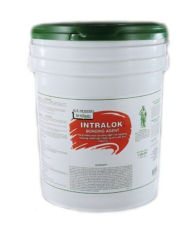 Thanks, Robert, that's an interesting question.
Thanks, Robert, that's an interesting question.
In my inexpert OPINION yes, there may be no bond and could be future frost damage if we pour a pad 2 days before setting a post and adding concrete around it. In fact it's probably likely.
Your plan to brush on a bonding agent is exactly what I'd do, along with vacuuming out the loose dirt and debris that will have fallen onto the top of the concrete if you don't also use Sonno Tubes.
If you use a product like IntraLok you can use the same additive both as a brush-on bonding agent and as an additive to the two concrete mixes themselves.
"INTRALOK bonding agent is a high solids, water-based emulsion admixture suitable for modifying Portland cement compositions. It is also designed for use as a bonding agent between new and hardened concrete. " - https://www.wrmeadows.com/intralok-concrete-bonding-agent/#ds
Here is an instruction sheet from the same source:
INTRALOK® Bonding Agent and Integral Mix/Admixture (2004) [PDF] W.R. Meadows, 300 Industrial Drive / P.O. Box 338 Hampshire, IL 60140-0338 USA Phone: (800) 342-5976 (847) 214-2100 E-mail: wrmil@wrmeadows.com Website: https://www.wrmeadows.com/ Tel: North America: 800.342.5976 Worldwide: 847.214.2100
On 2020-06-17 by Robert
Hello we are about to do a big fence job in Toronto, Ontario. We need to float some metal posts so the installer is proposing this:
1) Pour appox 12" of regular cement (portland & crushed stone) in the bottom of each fence hole. Let is set for a day or two.
2) Next, set the post on top of the cement and fill the rest of the hole up to the surface with Quickrete Fence N' Post.
My question is, will there be any bonding issues between the two layers of cement? Or should we be ok since the regular cement have been poured 48 hours prior? My concern is water getting between the two layers of concrete, freezing/thawing, and causing movement and post heaving.
If we need to apply a bonding agent then we'll have to get creative as to how to get it down 36" or so into a 8" wide hole and without disturbing the dirt. Maybe I'll have to use sono tubes and duct tape a brush on the end of a broom handle to properly spread the bonding agent?
Thank you for any suggestions on this matter.
On 2020/03/04 by (mod) - inspect cold pour joints for integrity
Yep that is a typical cold pour joint. I do not assume that it's a problem - as we explain above on this page, Lynn, though a closer inspection of the cold pour joint for coarseness or openings can give a better idea if there's a risk of wall leaks after backfill or later in the life of this building.
On 2020/03/04 by Lynn:
Is this a cold pour joint in our new foundation wall [original posting text lost - Ed. ]
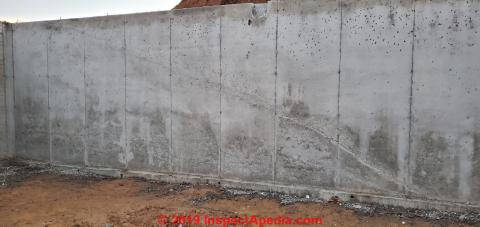 On 2019-12-13 by (mod) - contractor & home buyer opinions about cold pour joint in a new foundation
On 2019-12-13 by (mod) - contractor & home buyer opinions about cold pour joint in a new foundation
Searching using the on-page InspectApedia search box just above for "concrete crack sealants" lists some products and guidance at
SEAL CRACKS in CONCRETE, HOW TO
On 2019-12-13 by HomeBuyer703
Hi Dan
What would you suggest as an effective seal for cracks and gaps?
On 2019-12-12 by (mod) - "Tar patching" is not an effective seal against gaps, cracks, openings in masonry
IMO "Tar patching" is not an effective seal against gaps, cracks, openings in masonry. It is an effective "damp proofing" coating that retards moisture moving through the wall, but it does not reliably bridge actual cracks or gaps or openings and will dry out and crack itself over time.
It would also be helpful to know what secondary spray "foundation coating" was applied, since some coatings may not adhere well to "tar" or asphalt coatings previously applies.
However a cold pour joint by no means assures that there will be a foundation leak. Most cold pour joints do not leak through the wall; only severe or large joints are likely to exhibit that risk.
Also the use of a foundation drainage board around the foundation is an effective way to give an easier path for water against the foundation to flow down into the footing drains (and thus be carried away) than would be the path penetrating the foundation wall itself.
On 2019-12-1 by HomeBuyer703
The construction manager just responded to inquiry:
"The concrete pour does have a cold joint in the wall. There is continuous steel running vertical at predesigned internals along with horizontal steel. To ensure a dry, water tight strong basement we take the following steps.
First the yer70 foundation (fdn) vendor trials a tar patch over any voids, secondly he then he sprays the entire fdn with "foundation coating".
We add an additional step that is over and above required building codes to all of our houses. We have our concrete vendor install "drain board" around all of the foundation that is below grade or dirt level around the house.
These three steps ensure a water tight foundation combined with steel and design mix of the concrete, makes for a water tight and extremely strong foundation."
Does that sound like it should be ok?
On 2019-12-12 by (mod) - DC Metro, in Fairfax county, VA concrete foundation cold pour joint crack discussion
It would be nice if the contractor or anyone could snap photos of the work being done including those drainage mats (a nice addition); that can resolve future worries.
On 2019-12-12 by HomeBuyer703
We're in the DC Metro, in Fairfax county, VA to be exact. So we have all four seasons, temperature ranges from the single digits to 100 degrees Fahrenheit. We get a good amount of rain through out the year.
Yes I believe there are footing drains installed.
The construction manager also mentioned during our pre-construction meeting that they would be installing Drainage boards against the outside foundation walls as well.
On 2019-12-12 by (mod) -
NH
That may be fine;
What are the country and city where this home is being built? (Climate?)
Were footing drains installed, taking water to daylight?
Keep roof drainage directed well away from the home as soon as the roof is covered.
On 2019-12-12 by NewHomeBuyer703
Hi Dan
Thanks so much for the prompt response.
I'm not able to see the outside wall because it's below grade and already filled in. Any other way for me to check? I've attached a close up of where there's the biggest separation I can see.
Thanks again!
On 2019-12-12 by (mod) -
Yep that's a cold pour joint. It's not likely to be an issue unless it's through the wall and is likely to leak.
Now's the time to inspect carefully - on the outside of the foundation wall, and to seal it outside if needed.
On 2019-12-11 by NewHomeBuyer703
Hello,
I'm in the process of getting my home built. I went by the construction site today and noticed this long diagonal crack that goes from the top of the wall down to the bottom.
Looking through your site it appears to be a Cold Pour joint. But hope you can make a better determination. I'm only able to upload 1 pic, so I'll do one of from a distance.
But have many more. And if this is a Cold pour joint, is there anything I need to ask the builder to do to prevent future seepage?
Thanks so much!
On 2019-08-20 by (mod) -
PS I"m not thrilled to see a lot of standing water inside the foundation but that's pretty common during construction;
Let's hope that the contractor is installing a good footing drain around the foundation's footing outside the structure and that the footing drains extend to daylight.
Thanks! I will get a closer look today.
On 2019-08-20 by (mod) - our contractor says this is not a cold pour joint
Of course it's a cold pour joint. There's not a shred of argument to the contrary that's sensible.
However "cold pour joint" isn't necessarily a problem - it can simply be a visual effect of the meeting of two different pours of concrete into the wall forms.
A "cold pour joint" that would be a "problem" meriting further action would be one that has openings through the wall that will form future leaks through the foundation wall, or in more unusual and extreme cases, a cold pour joint could be so poorly adhered between the two pours as to actually weaken the foundation wall's resistance against lateral forces.
From your photo - which is admittedly distant, not detailed, and incompelte, I cannot see any sign that your particular cold pour joint is one giving the problems cited above. Take a closer look.
Sealing the joint would be appropriate only if there are actually penetrations or openings likely to leak through the wall; If that proves to be the case, a combination of geotextile reinforcement and a compatible sealant bonded to the wall should work; some use polyurethane; discuss sealant choice with your building supplier to be sure it's suitable for fresh concrete. Just painting on a mortar-based sealant paint won't handle future leaks that can occur when cementious coatings crack or flake away in response to temperature changes.
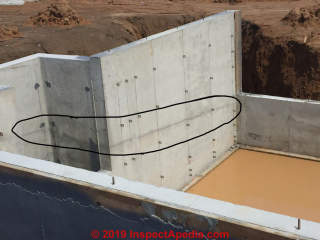 PS I"m not thrilled to see a lot of standing water inside the foundation but that's pretty common during construction;
PS I"m not thrilled to see a lot of standing water inside the foundation but that's pretty common during construction;
Let's hope that the contractor is installing a good footing drain around the foundation's footing outside the structure and that the footing drains extend to daylight.
On 2019-08-20 by Chad
We are building a new home and recently had concrete poured for our foundation walls.
On two walls we have a seam on the inside/outside that appears to be potentially a cold joint.
The concrete sub contractor doesn’t believe this is a true cold joint but wanted to get another opinion and get recommendations for sealing this to prevent future seapage/leaks. Thanks!
On 2019-07-01 by (mod) - should I be worried about this cold pour joint?
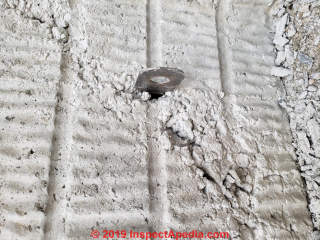 CIndy
CIndy
When the exterior is accessible I prefer to seal cracks on the outside - it's generally more reliable to keep water out of a structure than to let it inside and then try, like the little Dutch boy at the Dike, to stop it with your thumb at the very last possible moment.
Not all cold pour joints form leaks in a wall but joints that look very open might leak down the road.
But any exterior sealant has to be compatible with the (nearly useless) damp proofing bitnumnous coating the builder has alraedy applied.
On 2019-07-01 by Cindy
We have a newly poured foundation that looks to have some cold pour lines. We wanted the cracks fixed both inside and outside. The contractor did come a fix a small amount of the crack but only on the inside.be. They had already sprayed the tar and put up the foam board. We do have reinforced walls with rebar.
Should I be concerned about the outside not getting fixed if it is covered with the foam board?
There a more of these lines on the foundation walls for our garage. I am not as concerned about those they will be completely underground and not part of our basement...should I be concerned? I have attached a small section of the crack this crack runs nearly the entire length of the wall diagonally.
On 2017-07-21 by (mod) -
John, probably not in a reinforced foundation; sometimes a very dry cold pour joint will leak - fixed by sealing outside the wall before backfill. Send me photos of the joint and we might be able to comment further - use the page top/bottom CONTACT link
On 2017-07-21 by john
my contractor started the foundation but he finished late at about 11:pm but did no complete. he restarted at about 6am next day. would that be a major problem?
On 2017-07-02 by Sandy Wilson
Had my home built one year ago. Water leaks in basement walls and builder injected 168 points of epoxy, but I still have leaks and builder is refusing to do anything else. Please help me determine what the cause is. I believe it may be cold pour joints.
The walls all have a flaky look and pieces of concrete falling off little by little. Outside foundation has hundreds of holes (some 1/2 inch deep). Is there any way to send you pics? I'm 57 year old female and don't know where to turn.
On 2017-03-24 by (mod) - I see water leaking from the cold pour joint in several places
Good paying-attention, Mike.
Chances are the leak is a water problem, not a structural one when we see leaks at a cold pour joint, but of course water damage and frost can turn into other damage.
My experience with foundations pinned right to rock is that keeping water out is hell when rock slopes towards the foundation because any water that finds its way through soil down to the rock runs screaming towards the structure - and it's difficult to keep it out - since in normal construction the foundation's job and conception is to support the structure, not to serve as a boat.
The stopgap solution is indoor sealing openings with hydraulic cement - that'll slow down the little water molecules.
The right and effective solution involves outside steps:
make sure the roof gutters are clear and draining and that the drainage is dumped at a spot from which water will keep going away - not back towards the home - that means considering the shape of underground rock too.
If water keeps coming in during prolonged dry weather
.. either there's a surprising spring wetting the house - not likely as codes don't normally let a builder be so stupid as to build the house with its foundation under water -
.. or there's a drain or supply pipe leak. Such leaks will (barring public sewer backup) slow or stop when no one is using water in the home, but one way to track those down is to consider where pipes are located - where they run.
And look for leakage in those areas. E.g. I've found that a "foundation leak" blamed on "groundwater" was actually from a broken sewer pipe - water tended to follow the original sewer line trench back towards the foundation where it leaked in around the sewer pipe - something I thought ought to have been a clue to the home inspector.
Which prompts one to add: a trench for any buried piping can form a catch line that, depending on slope, directs groundwater towards the home.
Let me know if you have further questions, what you do, what you find.
On 2017-03-24 by Mike
I am in the process of purchasing a home built on a slight incline. Foundation is a solid pour done at least two parts, and several feet thick in places. There is not basement, just a big slab of concrete. There is a visible horizontal cold joint, and I see water leaking from this joint in several places under the master bath.
Current owner says that the ground on which the foundation is built is solid rock, and the water is rainwater that has found the cold joint as the path of least resistance.
So two questions:
(1) If owner is correct and this is rainwater, will that damage the foundation over time?
(2) How can I know for sure if it is or is not rainwater rather than a leaking pipe?
On 2016-10-16 by Ian Kiko
What is the effect of pouring a foundation in two layer. Is it acceptable?
On 2014-09-21 by (mod) -
Marvin, in the article above we illustrate a range of cold pour joints from harmless cosmetic to leaky. If your wall is reinforced concrete and the join is smooth, closed, not leaky most likely it's a cosmetic item. Of course from just your etext I can't see the wall. You can use our email found at our CONTACT link to send photos for further comment.
On 2014-09-21 by Marv
I am building a new house, the foundation has been poured and you can see the line where two pours meet, the builder says it was two pours and I need not worry, others have told me to be concerned, what should I do?
On 2014-08-26 0 by (mod) -
Anon
YOu can clean and use a concrete epoxy or drill and insert rebar - I prefer the latter.
On 2014-08-25 by Anonymous
HI,
I need to raise the footing under a wood post 12" thus creating a horizontal cold joint. My question is what would be the proper way to prep the area to create the best bond.
I'm also going to drill into the existing footing to add some rebar.
...
Continue reading at CONTROL JOINT CRACKS in CONCRETE or select a topic from the closely-related articles below, or see the complete ARTICLE INDEX.
Or see these
Recommended Articles
- CONCRETE CORROSION DUE TO HYDROGEN SULFIDE
- CONTROL JOINT CRACKS in CONCRETE
- DECK POST & PIER MISTAKES for some dodgy deck post and piers of poured concrete
Suggested citation for this web page
CONCRETE COLD POUR JOINTS at InspectApedia.com - online encyclopedia of building & environmental inspection, testing, diagnosis, repair, & problem prevention advice.
Or see this
INDEX to RELATED ARTICLES: ARTICLE INDEX to BUILDING STRUCTURES
Or use the SEARCH BOX found below to Ask a Question or Search InspectApedia
Ask a Question or Search InspectApedia
Try the search box just below, or if you prefer, post a question or comment in the Comments box below and we will respond promptly.
Search the InspectApedia website
Note: appearance of your Comment below may be delayed: if your comment contains an image, photograph, web link, or text that looks to the software as if it might be a web link, your posting will appear after it has been approved by a moderator. Apologies for the delay.
Only one image can be added per comment but you can post as many comments, and therefore images, as you like.
You will not receive a notification when a response to your question has been posted.
Please bookmark this page to make it easy for you to check back for our response.
IF above you see "Comment Form is loading comments..." then COMMENT BOX - countable.ca / bawkbox.com IS NOT WORKING.
In any case you are welcome to send an email directly to us at InspectApedia.com at editor@inspectApedia.com
We'll reply to you directly. Please help us help you by noting, in your email, the URL of the InspectApedia page where you wanted to comment.
Citations & References
In addition to any citations in the article above, a full list is available on request.
- Eric Galow, Galow Homes, Lagrangeville, NY. Mr. Galow can be reached by email: ericgalow@gmail.com or by telephone: 914-474-6613. Mr. Galow specializes in residential construction including both new homes and repairs, renovations, and additions.
- Paul Galow [Website galowconsulting.com ] - technical consultant on networking, LAN design, applications support. Galow Consulting Services [Website galowconsulting.com ] , 914-204-1749, email: paulgalow@galowconsulting.com
- "Concrete Slab Finishes and the Use of the F-number System", Matthew Stuart, P.E., S.E., F.ASCE, online course at www.pdhonline.org/courses/s130/s130.htm
- Mark Cramer Inspection Services Mark Cramer, Tampa Florida, Mr. Cramer is a past president of ASHI, the American Society of Home Inspectors and is a Florida home inspector and home inspection educator. Mr. Cramer serves on the ASHI Home Inspection Standards. Contact Mark Cramer at: 727-595-4211 mark@BestTampaInspector.com
- John Cranor [Website: /www.house-whisperer.com ] is an ASHI member and a home inspector (The House Whisperer) is located in Glen Allen, VA 23060. He is also a contributor to InspectApedia.com in several technical areas such as plumbing and appliances (dryer vents). Contact Mr. Cranor at 804-873-8534 or by Email: johncranor@verizon.net
- Cordon, William A. "Freezing and thawing of concrete-mechanisms and control." (1966).
- A Symposium. "Entrained Air in Concrete." In ACI Journal Proceedings, vol. 42, no. 6. ACI, 1946.
- Gokce, A., S. Nagataki, T. Saeki, and M. Hisada. "Freezing and thawing resistance of air-entrained concrete incorporating recycled coarse aggregate: The role of air content in demolished concrete." Cement and Concrete Research 34, no. 5 (2004): 799-806.
- Pigeon, Michel, and Richard Pleau. Durability of concrete in cold climates. CRC Press, 2010.
- Powers, Treval Clifford. "The properties of fresh concrete." (1969).
- Powers, Treval Clifford. "Void space as a basis for producing air-entrained concrete." In ACI Journal proceedings, vol. 50, no. 5. ACI, 1954.
- Powers, Treval Clifford, and R. A. Helmuth. "Theory of volume changes in hardened portland-cement paste during freezing." In Highway research board proceedings, vol. 32. 1953.
- Powers, Treval Clifford, and T. F. Willis. "The air requirement of frost resistant concrete." In Highway Research Board Proceedings, vol. 29. 1950.
- Verbeck, George J., and Paul Klieger. "Studies of'salt'scaling of concrete." Highway Research Board Bulletin 150 (1957).
- Whiting, David, and David Stark. "Control of air content in concrete." NCHRP report 258 (1983).
- Wright, Peter Joseph Frederick. "ENTRAINED AIR IN CONCRETE." In ICE Proceedings, vol. 2, no. 3, pp. 337-358. Thomas Telford, 1953.
- "Concrete Slab Finishes and the Use of the F-number System", Matthew Stuart, P.E., S.E., F.ASCE, online course at www.pdhonline.org/courses/s130/s130.htm
- Sal Alfano - Editor, Journal of Light Construction*
- Thanks to Alan Carson, Carson Dunlop, Associates, Toronto, for technical critique and some of the foundation inspection photographs cited in these articles
- Terry Carson - ASHI
- Mark Cramer - ASHI
- JD Grewell, ASHI
- Duncan Hannay - ASHI, P.E. *
- Bob Klewitz, M.S.C.E., P.E. - ASHI
- Ken Kruger, P.E., AIA - ASHI
- Aaron Kuertz aaronk@appliedtechnologies.com, with Applied Technologies regarding polyurethane foam sealant as other foundation crack repair product - 05/30/2007
- Bob Peterson, Magnum Piering - 800-771-7437 - FL*
- Arlene Puentes, ASHI, October Home Inspections - (845) 216-7833 - Kingston NY
- Greg Robi, Magnum Piering - 800-822-7437 - National*
- Dave Rathbun, P.E. - Geotech Engineering - 904-622-2424 FL*
- Ed Seaquist, P.E., SIE Assoc. - 301-269-1450 - National
- Dave Wickersheimer, P.E. R.A. - IL, professor, school of structures division, UIUC - University of Illinois at Urbana-Champaign School of Architecture. Professor Wickersheimer specializes in structural failure investigation and repair for wood and masonry construction. * Mr. Wickersheimer's engineering consulting service can be contacted at HDC Wickersheimer Engineering Services. (3/2010)
- *These reviewers have not returned comment 6/95
- Best Practices Guide to Residential Construction, by Steven Bliss. John Wiley & Sons, 2006. ISBN-10: 0471648361, ISBN-13: 978-0471648369, Hardcover: 320 pages, available from Amazon.com and also Wiley.com. See our book review of this publication.
- Decks and Porches, the JLC Guide to, Best Practices for Outdoor Spaces, Steve Bliss (Editor), The Journal of Light Construction, Williston VT, 2010 ISBN 10: 1-928580-42-4, ISBN 13: 978-1-928580-42-3, available from Amazon.com
- The Journal of Light Construction has generously given reprint permission to InspectAPedia.com for certain articles found at this website. All rights and contents to those materials are ©Journal of Light Construction and may not be reproduced in any form.
- Appliances and Home Electronics, - energy savings, U.S. Department of Energy
- Avongard FOUNDATION CRACK PROGRESS CHART [PDF] - structural crack monitoring
- Diagnosing & Repairing House Structure Problems, Edgar O. Seaquist, McGraw Hill, 1980 ISBN 0-07-056013-7 (obsolete, incomplete, missing most diagnosis steps, but very good reading; out of print but used copies are available at Amazon.com, and reprints are available from some inspection tool suppliers). Ed Seaquist was among the first speakers invited to a series of educational conferences organized by D Friedman for ASHI, the American Society of Home Inspectors, where the topic of inspecting the in-service condition of building structures was first addressed.
- Building Failures, Diagnosis & Avoidance, 2d Ed., W.H. Ransom, E.& F. Spon, New York, 1987 ISBN 0-419-14270-3
- Defects and Deterioration in Buildings: A Practical Guide to the Science and Technology of Material Failure, Barry Richardson, Spon Press; 2d Ed (2001), ISBN-10: 041925210X, ISBN-13: 978-0419252108. Quoting:
A professional reference designed to assist surveyors, engineers, architects and contractors in diagnosing existing problems and avoiding them in new buildings. Fully revised and updated, this edition, in new clearer format, covers developments in building defects, and problems such as sick building syndrome. Well liked for its mixture of theory and practice the new edition will complement Hinks and Cook's student textbook on defects at the practitioner level. - "Avoiding Foundation Failures," Robert Marshall, Journal of Light Construction, July, 1996 (Highly recommend this article-DF)
- Masonry structures: The Masonry House, Home Inspection of a Masonry Building & Systems, Stephen Showalter (director, actor), DVD, Quoting:
Movie Guide Experienced home inspectors and new home inspectors alike are sure to learn invaluable tips in this release designed to take viewers step-by-step through the home inspection process. In addition to being the former president of the National Association of Home Inspectors (NAHI), a longstanding member of the NAHI, the American Society of Home Inspectors (ASHI), and the Environmental Standard Organization (IESO), host Stephen Showalter has performed over 8000 building inspections - including environmental assessments. Now, the founder of a national home inspection school and inspection training curriculum shares his extensive experience in the inspection industry with everyday viewers looking to learn more about the process of evaluating homes. Topics covered in this release include: evaluation of masonry walls; detection of spalling from rebar failure; inspection of air conditioning systems; grounds and landscaping; electric systems and panel; plumbing supply and distribution; plumbing fixtures; electric furnaces; appliances; evaluation of electric water heaters; and safety techniques. Jason Buchanan --Jason Buchanan, All Movie Review - In addition to citations & references found in this article, see the research citations given at the end of the related articles found at our suggested
CONTINUE READING or RECOMMENDED ARTICLES.
- Carson, Dunlop & Associates Ltd., 120 Carlton Street Suite 407, Toronto ON M5A 4K2. Tel: (416) 964-9415 1-800-268-7070 Email: info@carsondunlop.com. Alan Carson is a past president of ASHI, the American Society of Home Inspectors.
Thanks to Alan Carson and Bob Dunlop, for permission for InspectAPedia to use text excerpts from The HOME REFERENCE BOOK - the Encyclopedia of Homes and to use illustrations from The ILLUSTRATED HOME .
Carson Dunlop Associates provides extensive home inspection education and report writing material. In gratitude we provide links to tsome Carson Dunlop Associates products and services.


